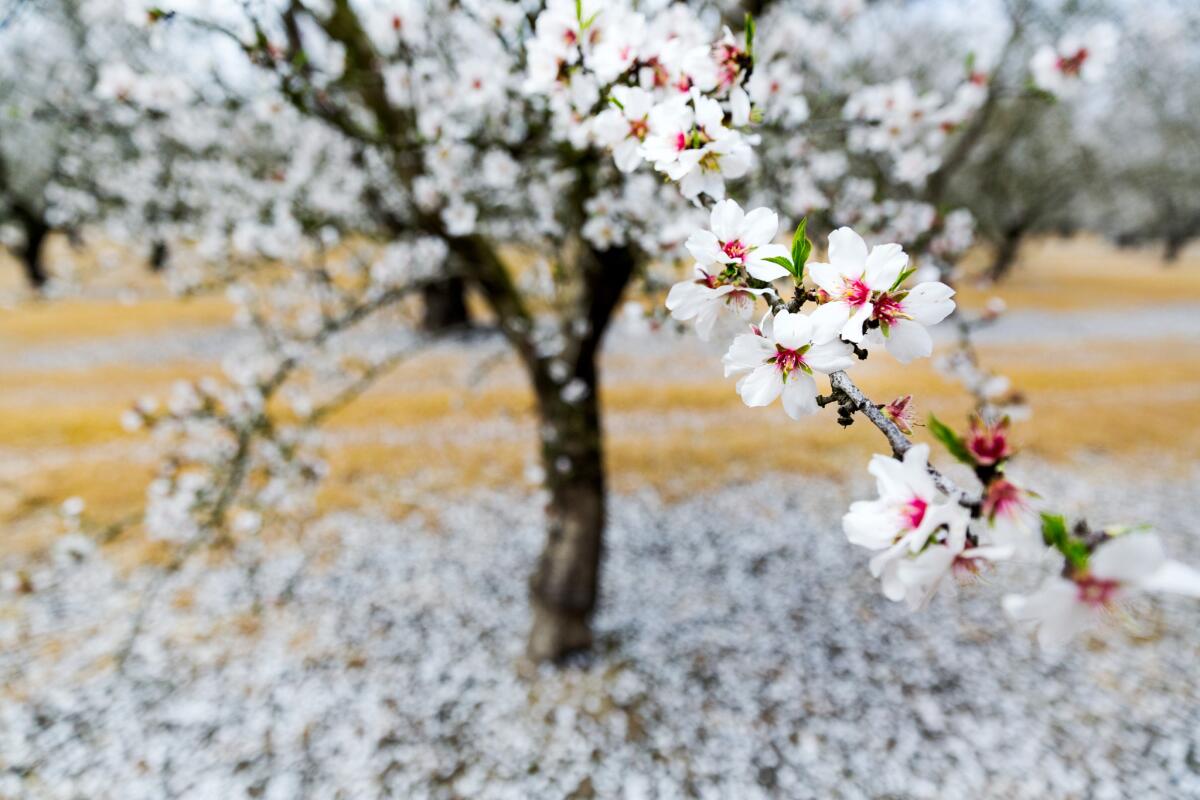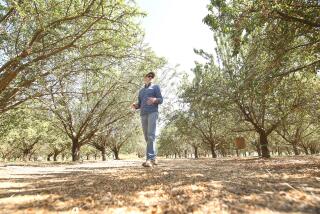Column: Almonds, the demons of drought? Frustrated growers tell another story

- Share via
Reporting from Wasco, Calif. — It’s not clear exactly when almonds became the scapegoat for the California drought.
Maybe it was last August, when the Atlantic posted “The Dark Side of Almond Use,” implicating the tasty little nut in every environmental crisis from bee colony collapse disorder to the struggles of the state’s Chinook salmon population.
Or maybe it was in February, when a headline in Mother Jones blared, “It takes how much water to grow an almond?!” (Profoundly misleading answer: 1.1 gallons per nut.)
Since then, the almond’s culpability for you name it — our depleting aquifers, our sinking topsoil, the heartbreak of psoriasis — has become an article of faith among finger-wagging pundits and environmental activists.
Oh, yes, they may admit, our snowpack is negligible because of a dearth of rain, but the real reason we are suffering our yellow lawns, unflushed toilets and shorter showers is because rapacious farmers with dollar signs where their souls should be insist on growing almonds.
------------
FOR THE RECORD:
Almond growers: In the April 17 California section, a photo caption that accompanied a column about almond trees and water usage said that the photo showed a farmworker spraying herbicide on almond trees. It was a foliar nutrient spray, not an herbicide. —
------------
Just this week, a New York Times food columnist noted, disapprovingly, that California exports most of its almonds to other countries, “which means, effectively, that we are exporting water.” His conclusion: “Unless you’re the person or company making money off this deal, that’s just nuts.”
Two friends have told me that when they walk into grocery stores, they now think twice about putting almonds into their cart. They don’t want to seem drought-insensitive. They don’t want to be almond-shamed.
::
Almond Girl is standing in her lush almond orchard on the outskirts of Wasco, a small town on Highway 46 about half an hour northeast of Bakersfield. She is a fourth-generation farmer, married to a fourth-generation farmer. Four months ago, the couple produced what they hope will be a fifth-generation farmer, a son named Henry.
Like so many almond growers, she is puzzled by the sudden demonization of her beloved crop.
“People need to understand that everything you eat takes water,” said Jenny Holtermann, 27.
She blogs about rural life as Almond Girl. “I think farmers need a voice,” she said, “and who better to tell our story than ourselves?”
Growing up on an almond and walnut farm in Chico, Holtermann was unaware of California’s water battles, of the enduring tensions between residential and agricultural water users. When she discovered it, she was taken aback. “Without us, what would you be eating?”
She was coy about the size of her family’s operation, and would describe it only as “small to mid-size.” Asking a farmer about her acreage, I guess, is like asking to see her bank account.
About 20 miles southeast of Wasco, in Buttonwillow, Greg Wegis, 39, was less reticent. He told me his family owns 2,400 acres, three-quarters of which are planted with almonds. Each acre of almond trees produces about 2,390 pounds of nuts. A pound sells for about $3.50. If you’re feeling nosy, you can do the math.
If you do, you can understand why cotton, lettuce and carrot farmers have become almond farmers over the last two decades. It’s where the money is.
Farmers are by necessity a stoic lot. But the assault on almonds, said Wegis, has been “very stressful.”
“I grew up listening to my father and grandfather talk around the dinner table, proud of doing something noble for California, and for America,” he said. “Now, we’re feeling like a scapegoat for over 30 years of water mismanagement in this state.”
He’s particularly bothered by the one gallon/one almond statistic. “They’re taking the total volume of water used and dividing it by the total pounds of nuts produced, but that does not tell the whole story.”
The nut, as it happens, is only a part of the almond. The rest — the shell and the hull — are put to efficient agricultural use. Shells, a hard wood, have all sorts of uses — fireplace logs, animal bedding.
Hulls are used as feed for dairy cattle. So almonds help make milk.
Tons of dead almond trees are ground up and used as biomass fuel for cogeneration plants. So almonds help make electricity.
Trees absorb carbon dioxide. So almonds help clean the Central Valley’s notoriously noxious air.
What I learned from talking to Wegis is that you really shouldn’t pick a fight with an almond farmer about his profligate water habits. He doesn’t have any.
::
Richard Waycott is chief executive of the Almond Board of California, the growers’ trade group. On Thursday morning, he told me he is in “a little bit of disbelief in being targeted the way we have.”
I asked him whether he thought his industry should have moved faster to counter the bad rap.
“There are so many journalists and bloggers out there that can put out whatever kind of headline they want, and when we react to something, we want to do it with facts, and facts don’t always win the day,” he said.
It’s true that almonds need water year round, which is not the case with many crops. In the last 20 years, though, most almond farmers have worked hard to reduce their consumption, largely with techniques like drip irrigation. Though the number of almond trees has increased more than 60% in that period, water consumption has remained flat.
Still, the water it takes to grow any vegetable, fruit or nut is a mere fraction of what is required to raise animal protein. An L.A. Times chart on water usage details the differences: It takes more than 106 gallons of water, experts say, to produce one ounce of beef.
The next time you hesitate before grabbing those almonds at Trader Joe’s, stop and think: When was the last time you were accused of wasting water for grilling a steak?
@AbcarianLAT
More to Read
Sign up for Essential California
The most important California stories and recommendations in your inbox every morning.
You may occasionally receive promotional content from the Los Angeles Times.











